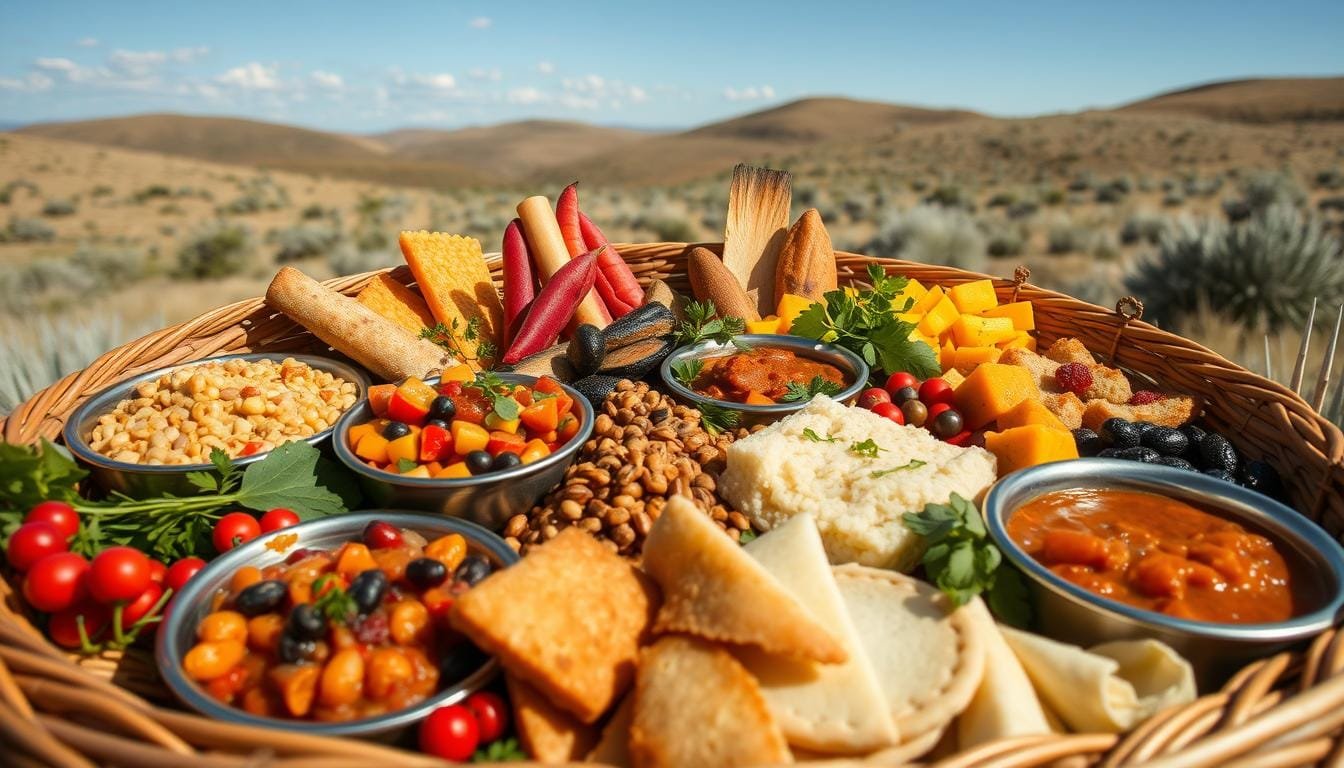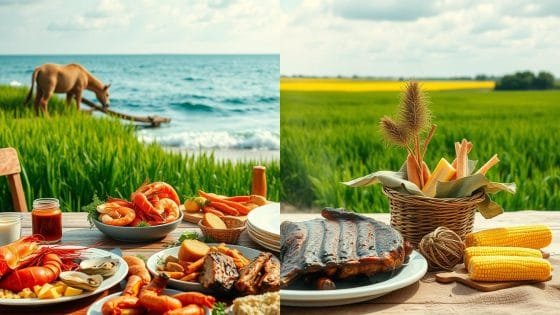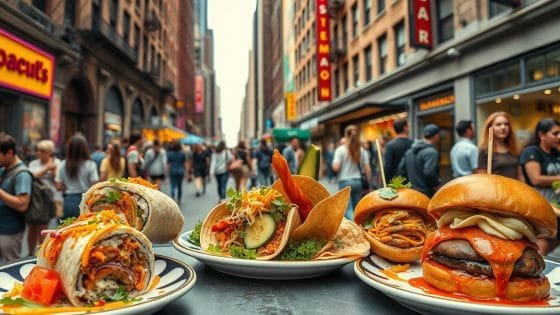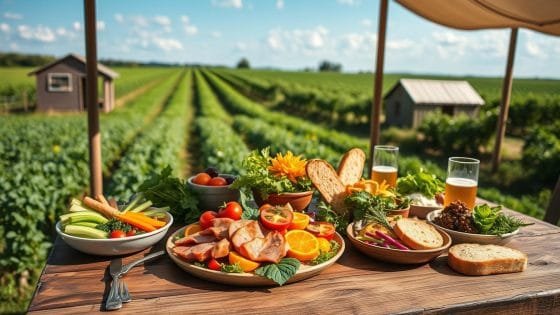The USA has a wide range of foods, thanks to its big geography and many cultures. Coastal areas are full of seafood, while inland is all about farming. This shows how different places in America have their own special foods.
Coastal spots are known for their seafood, like clam chowder. Inland areas, on the other hand, have dishes like casseroles. These differences make each region’s food special and unique.
Looking at coastal and inland foods, we see how place, history, and culture shape American food. Maine’s lobster rolls and Kansas City’s barbecue are just a few examples. Each place has its own food story, showing its environment and heritage.
Historical Development of Regional American Cuisines

The rich tapestry of regional culinary traditions in America reflects a fascinating journey through time. From Native American cuisine to colonial cooking methods, our food landscape has been shaped by diverse influences.
Native American Culinary Origins
Native American cuisine forms the bedrock of American food culture. Indigenous communities across North America relied on corn as a staple, showcasing sophisticated farming techniques. They introduced squash, pumpkin, beans, and peppers to European settlers, ingredients that remain prevalent in Southern cuisine today.
Colonial Influences on Cooking Methods
Colonial settlers brought European techniques and ingredients, significantly altering the culinary landscape. New England cuisine, for instance, was heavily influenced by English traditions, with a preference for baking over frying. European colonists introduced sugar, flour, milk, eggs, and livestock, fundamentally changing the way Americans ate.
Immigration Impact on Regional Food Cultures
The 19th century saw a wave of immigration that further diversified American cuisine. Irish, Portuguese, and Italian immigrants brought their own flavors and cooking styles. This immigration influence on food is particularly evident in dishes like gumbo and jambalaya in Southern Louisiana, which blend West African, French, and Spanish influences.
| Region | Culinary Influences | Signature Dishes |
|---|---|---|
| New England | English | Clam chowder, baked beans |
| Southern | African, Native American, European | Fried chicken, cornbread |
| Cajun/Creole | French, West African, Spanish | Gumbo, jambalaya |
| Tex-Mex | Mexican, Indigenous | Chili con carne, fajitas |
USA coastal vs inland food: A Geographic Comparison
The United States has a wide range of foods. This is because of its big geography. From sea to land, the food shows the country’s varied landscape.
Coastal Seafood Traditions
Seafood is king along America’s coasts. The Pacific Coast offers salmon, sturgeon, and Dungeness crab. The Atlantic Coast is famous for cod, lobster, and blue crab.
Heartland Agricultural Practices
The interior is all about farming. The Midwest, known as America’s breadbasket, grows corn, soybeans, and beef. These foods are the heart of many dishes, unlike the seafood of the coast.
Regional Ingredient Availability
What you can find to eat changes a lot across the country. California’s climate lets it grow a wide variety of foods. The Central Valley is a big farm area that grows many fruits, vegetables, and nuts.
Preservation Methods and Techniques
Coastal and inland areas use different ways to keep food fresh. The coast smokes and salts fish. The interior smokes and cures meats. These old ways add to the taste of each area.
| Region | Key Ingredients | Signature Dishes | Preservation Methods |
|---|---|---|---|
| Pacific Coast | Salmon, Dungeness crab | Cioppino, Grilled salmon | Smoking, Canning |
| Atlantic Coast | Cod, Lobster | Clam chowder, Lobster roll | Salting, Drying |
| Midwest | Corn, Beef | Corn on the cob, Pot roast | Curing, Freezing |
| California | Avocados, Almonds | Fish tacos, Cobb salad | Dehydrating, Pickling |
Modern Regional Cooking Styles and Influences
Today’s American food is a mix of old and new flavors. The farm-to-table movement is big, making chefs use local foods and care for the planet. In New England, old favorites like clam chowder and lobster rolls are getting new life. They’re also tackling issues like climate change that affect crops like blueberries and coffee.
Fusion cooking is big, especially by the sea. California’s food scene is a perfect example, with dishes like Mission-Style Burritos. Inland, chefs are making comfort foods their own, like the Midwest’s hotdish and fried cheese curds.
More people want healthy food, leading to more vegan and vegetarian choices. Even in meat-loving places, you can find plant-based options. Coastal fishing is also changing, focusing on keeping the sea healthy while giving diners fresh seafood.
The future of American food is exciting. From the Southwest’s Hatch Green Chile to the Pacific Northwest’s Geoduck, each place is adding its own twist. This means every meal, whether by the sea or inland, is a special treat that’s both traditional and new.



